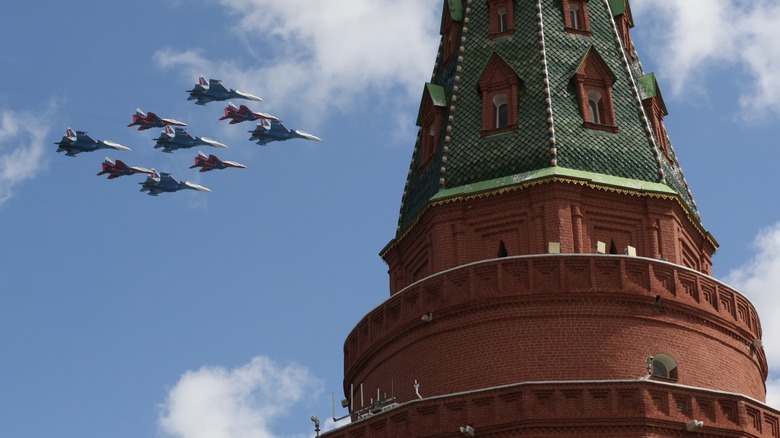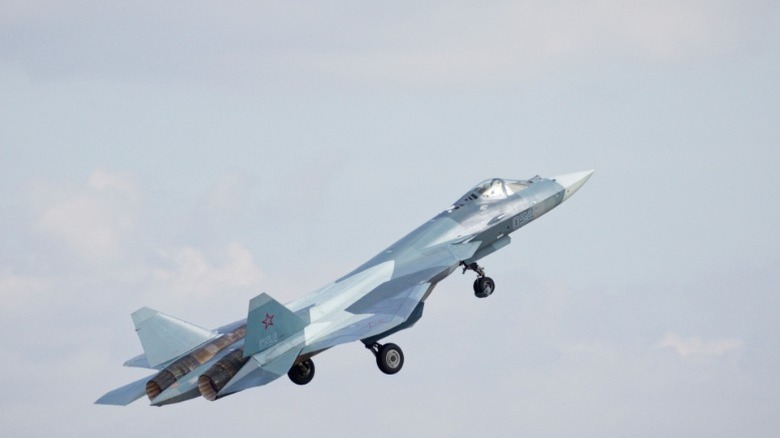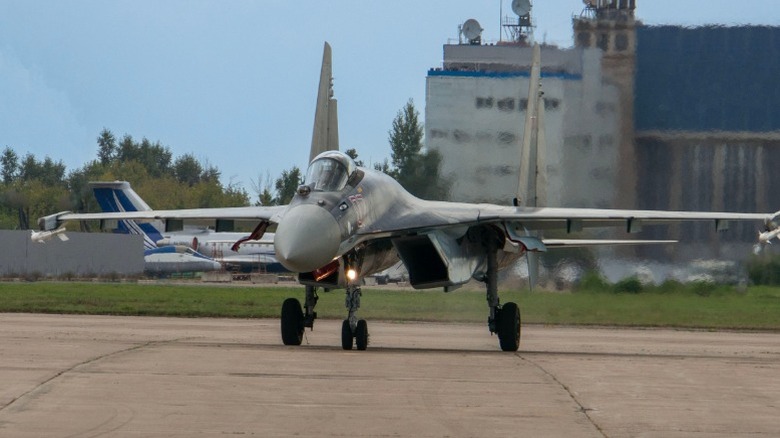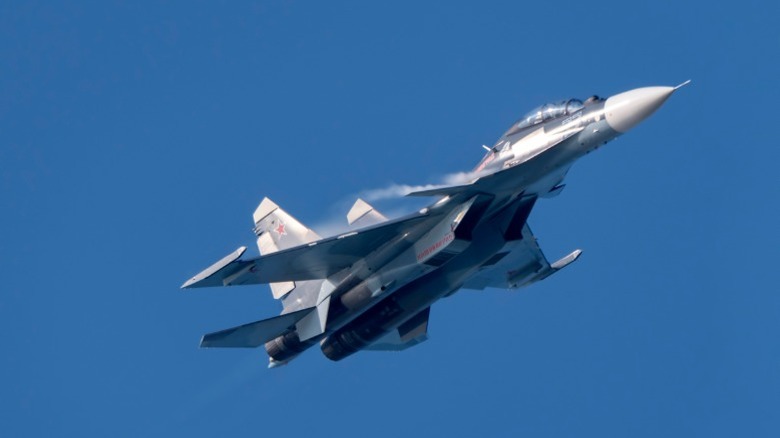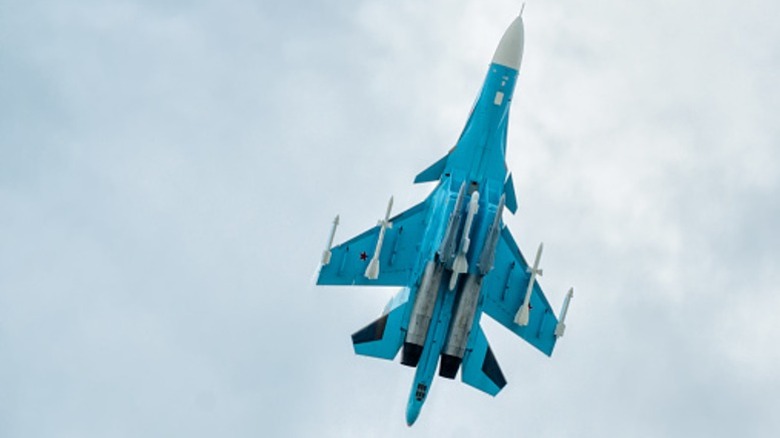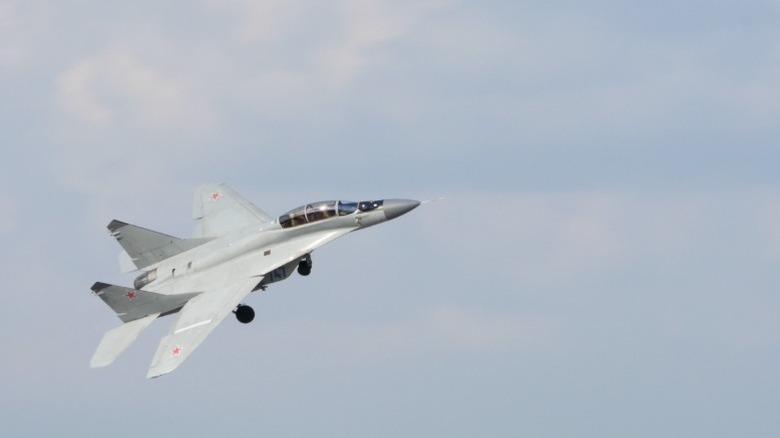5 Of The Newest Russian Fighter Jets In Its Fleet
Modern-day warfare doctrine demands control of the skies, and fighter jets are key to achieving that domination. Honed by decades of trial and error during the Cold War, a period that saw the Soviets field some of the most legendary fighters in aviation history, Russia has a robust aviation industry capable of designing and fielding state-of-the-art fighters at scale. Although the Russian Air Force and naval aviation largely operate Soviet-era machines, some newer members have joined the fleet in recent years, most of which are significant upgrades of already existing designs.
The lion's share of Russia's newest frontline fighters hail from the state-owned Sukhoi Design Bureau, now under the larger United Aircraft Corporation. As expected, many of these aircraft will eventually be replaced by even newer, next-generation platforms. Pending when the latter's designs mature into actual serial models, the Russian Air Force will simply continue with its current inventory.
Sukhoi Su-57 Felon
Making its maiden flight in 2010, the Sukhoi Su-57 (code-named "Felon" by NATO) is the youngest class of fighter in the Russian fleet. Nimble, supersonic, and sporting advanced avionics such as the N036 Byelka Active Electronically Scanned Array (AESA) radar suite, it is also the country's most advanced. The Su-57 is billed as the answer to America's fifth-generation stealth F-22 Raptor and F-35 Lightning II jets.
On paper, the Su-57 features similar hallmarks: angled tail fins, a tandem weapons bay, a blended fuselage, and a coat of radar-absorbent material for reduced observability. Unique N036B-1-01 cheek radars grant increased angular coverage. But international experts aren't entirely sold on its capabilities.
While the F-22 and F-35 boast cutting-edge Pratt & Whitney F119-PW-100 and F135 engines, respectively, the Su-57 still mounts a pair of Saturn AL-41F1 engines from the older Su-35 Flanker, pending the completion of the more capable Izdeliye 30. In addition, its radar cross-section is believed to be larger than that of the F-22 or Chinese Chengdu J-20, partly due to less refined air inlets and exposed exhaust nozzles, raising questions about its stealth performance. Numbers also pose a limitation: only about two dozen serial airframes are in service today. Even with these constraints, the Su-57 represents the newest fighter in the Russian fleet and provides a marked improvement over earlier fourth-generation models.
Sukhoi Su-35 Flanker
Unveiled in 2007 with the latest "M" and "BM" variants, the Su-35 represents the most modernized derivative of the Su-27 Flanker family. While lacking fifth-generation stealth features, it is classified as a "4++ generation" platform. As with other Flanker variants, the Su-35 is designed to be super maneuverable; it remains among the most agile fighter jets in service. Powered by twin Saturn AL-41F1S turbofans (about 64,000 lbf combined), the Su-35 has excellent acceleration and can reach around Mach 2.25 at altitude. Thrust-vectoring nozzles permit maneuvers like the Pugachev's Cobra, demonstrated in dogfighting scenarios and airshows.
For scanning the skies at long ranges, the Su-35 houses the Irbis-E Passive Electronically Scanned Array (PESA) radar, which has a detection range between 350 km and 400 km. Its under-wing pylons support Russia's full suite of modern air-to-air missiles, including the short-range R-73 (and K-74M successor), the medium-range R-77 series, and ultra-long-range R-37M. Mounted on each wingtip are Khibiny-M electronic warfare pods. When an enemy gets too close for comfort, the Su-35 can engage with a traditional solution: the 30 mm Gryazev-Shipunov GSh-301 autocannon loaded with 150 rounds.
Over 100 airframes are currently in active service, and more are rolling off the production line. While production of the Su-57 remains limited, the Su-35 continues to form the backbone of Russia's fighter fleet.
Sukhoi Su-30
Although its origin predates the Su-35 by almost two decades (making it one of the earliest Flanker variants), the Su-30 has undergone several modernization programs, resulting in models such as the SM and SM2 in the 2020s. In line with other improved derivatives of the Su-27, the Su-30 bears similar physical traits to the original airframe. But the differences run deeper. It features a distinctive twin-seat cockpit that houses a pilot and a weapons system officer, designed for lengthy missions. Some versions even have canards to compensate for the extra weight and improve pitch control at high angles of attack.
Envisioned as a true multirole fighter, the Su-30 emphasizes mission endurance. Twin AL-31FP engines power it, each generating 27,000 pounds of thrust and propelling it to top speeds of Mach 1.75. Thanks to these engines and a widened fuselage to make way for more fuel, the Su-30 can operate at ranges of 1,864 miles and at altitudes of up to 56,000 ft. A retractable in-flight refueling probe and provision for external tanks further extend this range.
Although the newest SM2 models boast the Irbis-E radar, other models use the less advanced N011 Bars passive electronically scanned array radar. Regardless, this still grants the Su-30 the ability to detect large aerial targets as far as 250 miles (400 km). Russia exports the Su-30 widely, with modifications tailored to different customers.
Su-34 Fullback
Dubbed the "Fullback" by NATO, the Su-34 is intended to be the mainstay tactical bomber of the Russian Air Force. After decades in development difficulties during the years leading up to and after the collapse of the Soviet Union, the strike-fighter finally welcomed into service in 2014. The Su-34 combines the airframe of the Flanker with the side-by-side cockpit seating of the Su-24 Fencer and Tupolev Tu-22, which it was designed to replace. A duck-bill-shaped nose cone and an extended tail sting housing the auxiliary power unit give the Su-34 a distinctive duck-like profile, earning it the nickname "HellDuck."
Although capable of engaging in aerial combat with R-77 and R-73 missiles, the Su-34 is primarily assigned to strike missions. Notably, it can carry a diverse suite of weaponry under 12 hardpoints, including Kh-59 air-to-surface missiles, Kh-35 and P-800 Oniks anti-ship missiles, and Kh-31 anti-radiation missiles. Registering 49,604 pounds in empty weight, it is the heaviest Russian fighter, and the added space also allows for a large internal fuel capacity. Powering it are a pair of AL-31FM1 engines that generates roughly 30,000 pounds of thrust each.
In the world of fighter aircraft, where space is a luxury, pilots aboard the Su-34 have room to stand and move, heat food in a galley, and use relief tubes when necessary during long missions.
Mikoyan & Gurevich MiG-35 Fulcrum
A product of the Mikoyan & Gurevich Design Bureau, the MiG-35 was developed to revive international interest in the ageing Cold War-era MiG-29 Fulcrum. Variants like the MiG-29M and the Navy's MiG-29K appeared along the way, but the most modern version to date was unveiled as the MiG-35 at the Moscow Air Show in 2017, about 40 years after the first Fulcrum flew. The MiG-35's similarities with its predecessors end with the airframe design; pretty much everything else is newer technology.
Gone are the N019 Pulse-Doppler radars of the base models. In their place are the Zhuk-ME PESA radars, with the Zhuk-AE AESA radar offered as an optional upgrade — Russia's first AESA radar — and RD-33MK engines. The Zhuk-AE radar can sweep the skies at a 100-mile range and track up to 30 targets simultaneously. The RD-33MK engines generate 19,842 pounds of thrust each, about 7% more than the original RD-33. Together with improved fuel capacity of 4,800 liters, the MiG-35 can reach speeds of Mach 2.25, ranges of 1,242 miles, and altitudes of 52,000 feet.
Complete with full multirole capability and situational awareness features, including air-to-air sensors, air-to-ground laser targeting pods, Khibiny-M jamming pods, and an improved helmet-mounted sight, the MiG-35 nevertheless failed to fulfill its intended role as an export platform. Hence, only six airframes are in active service, all within Russia.
